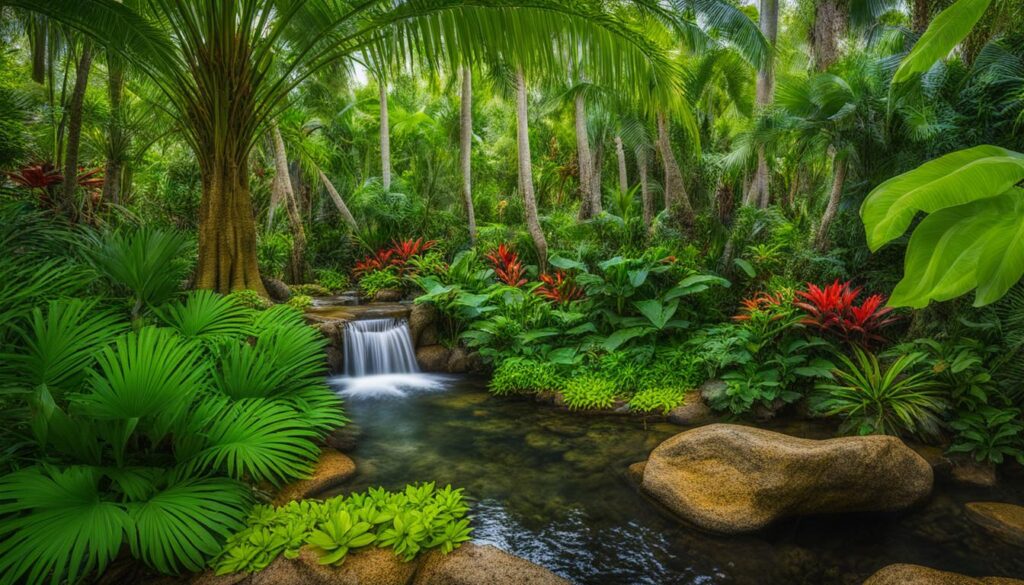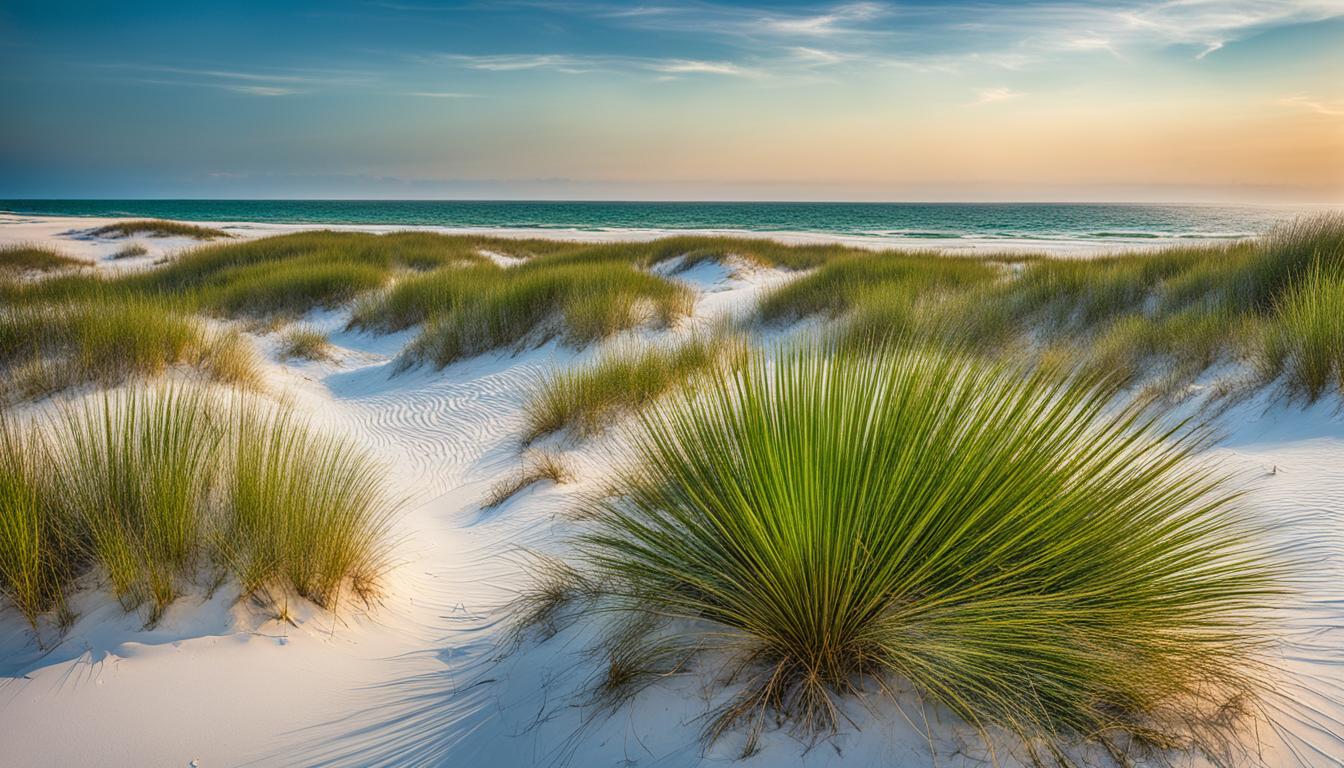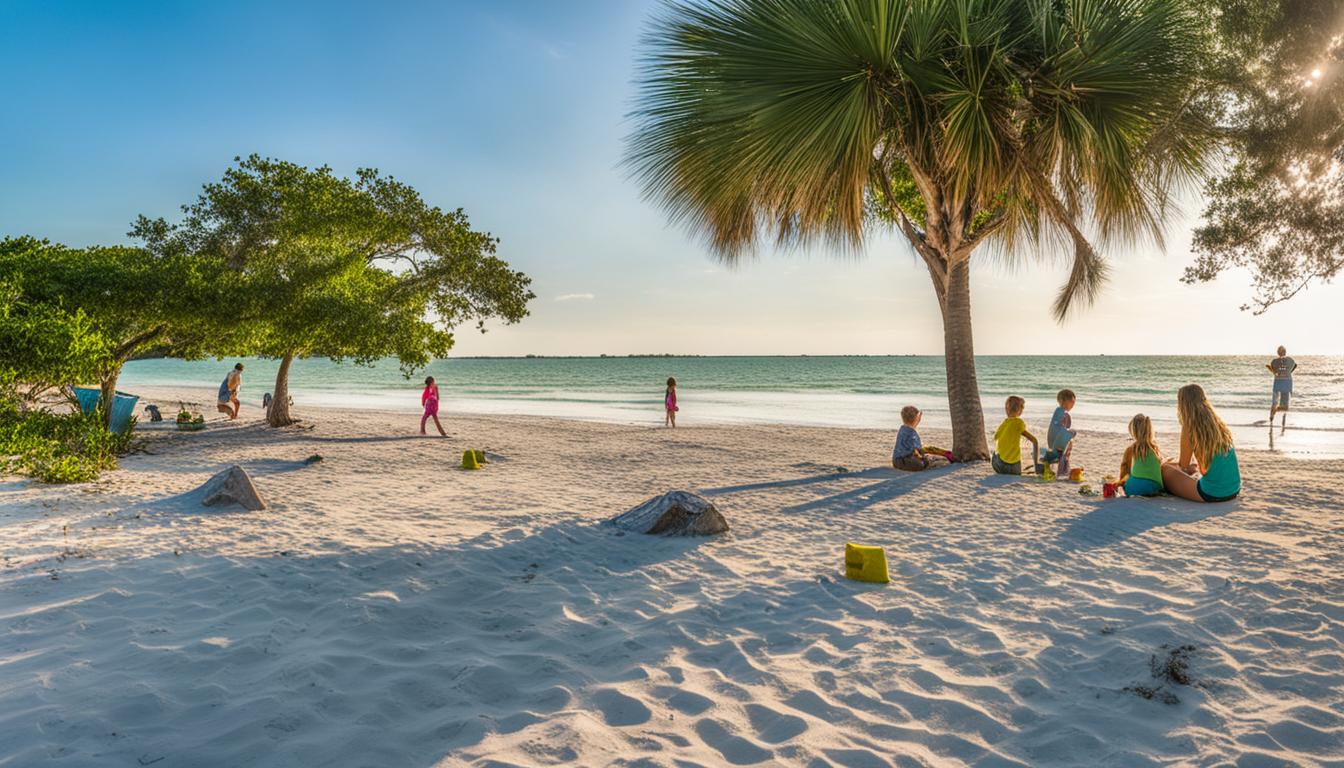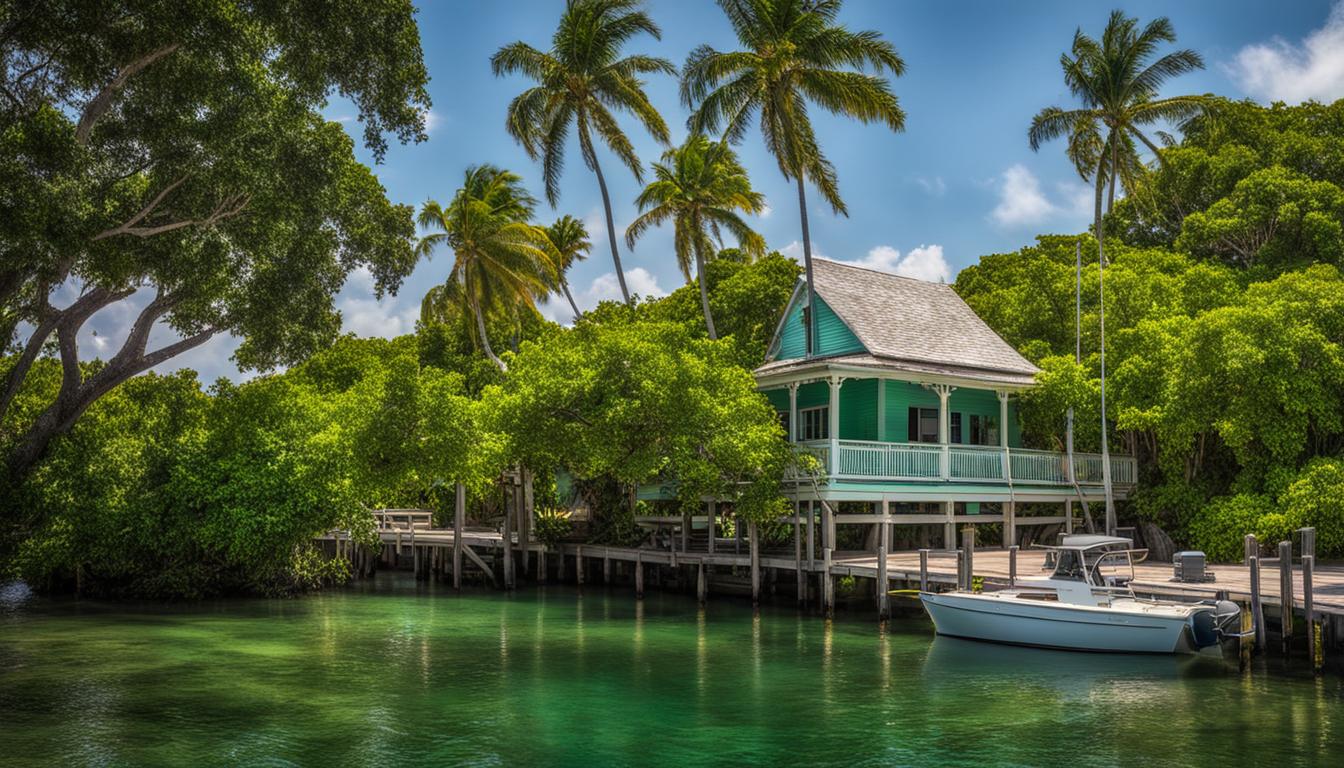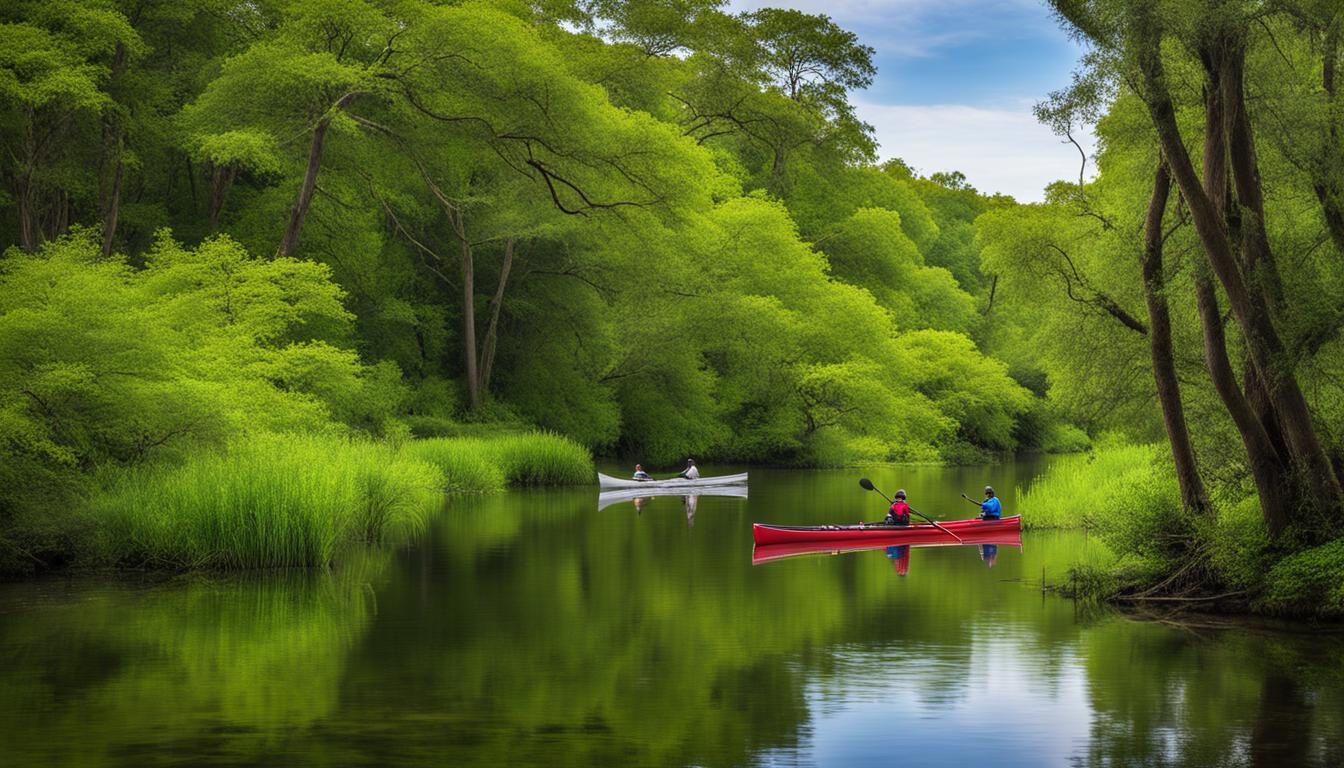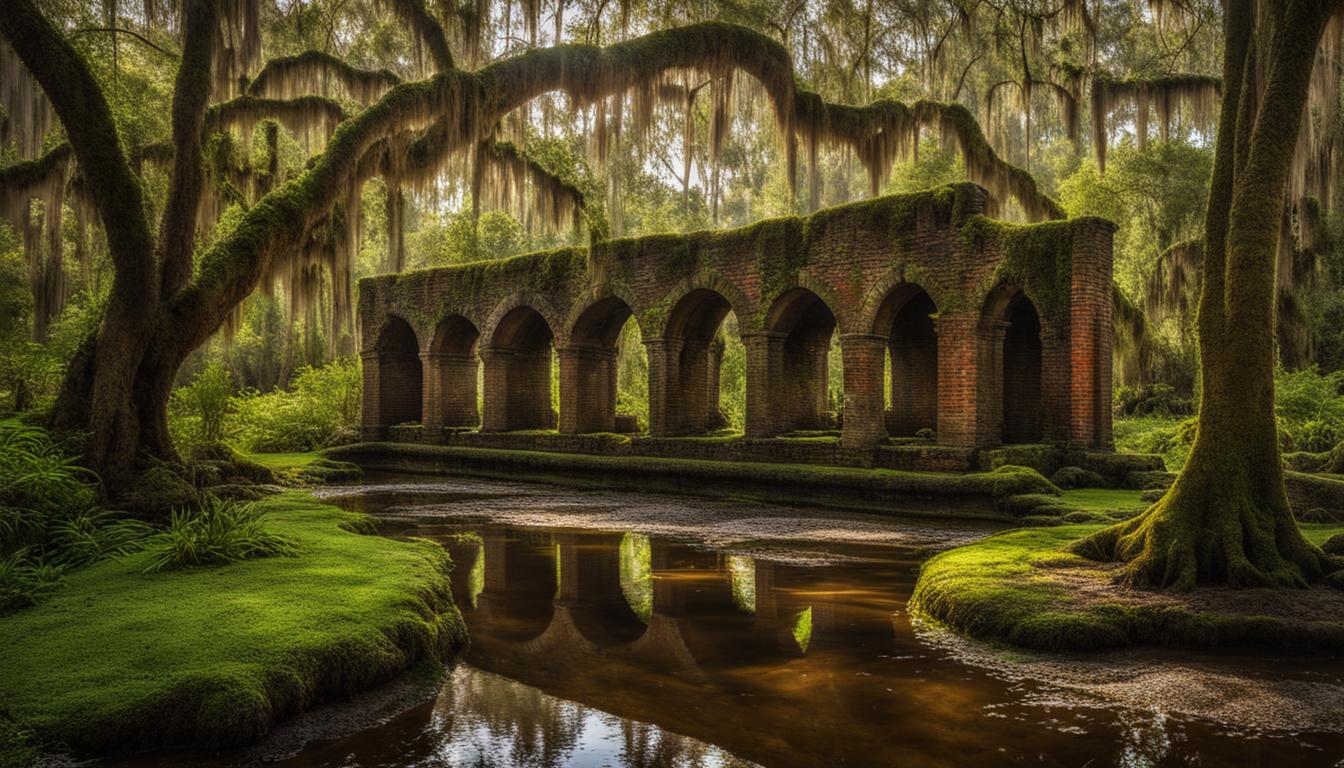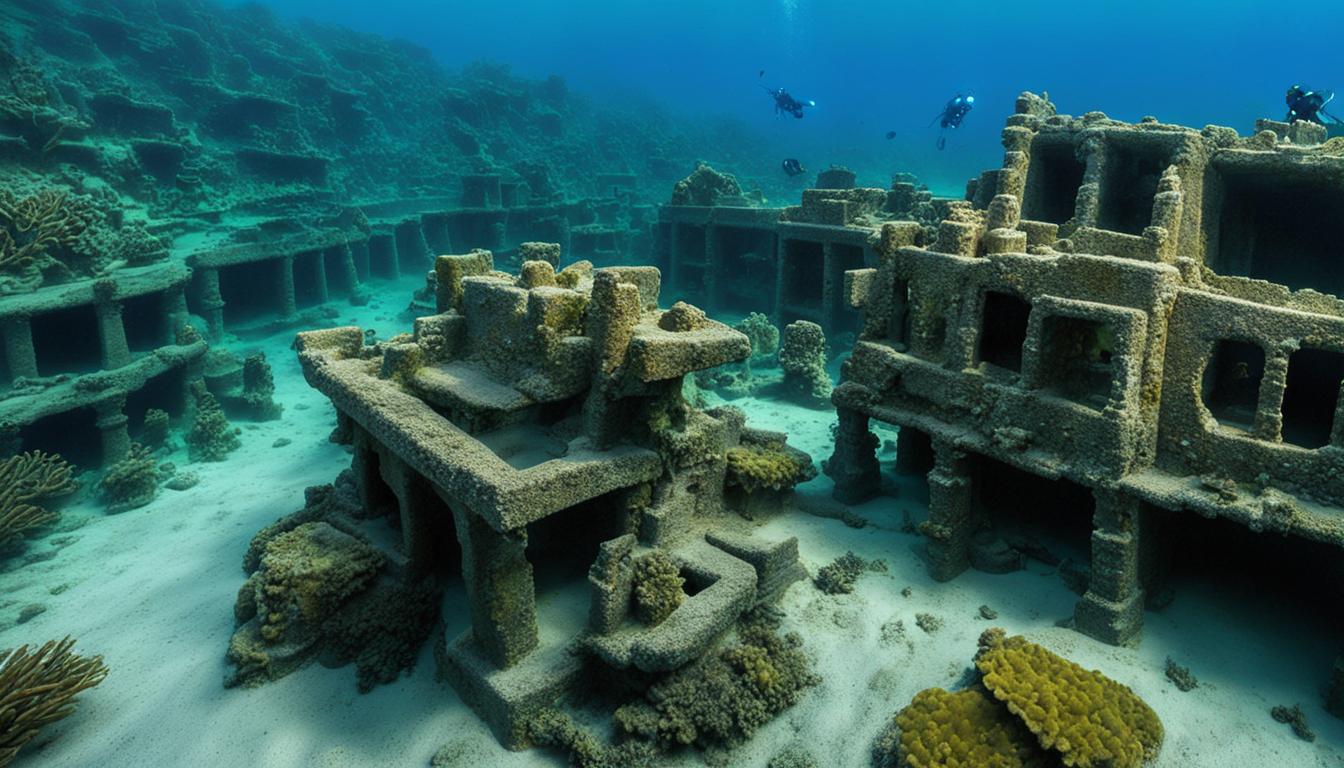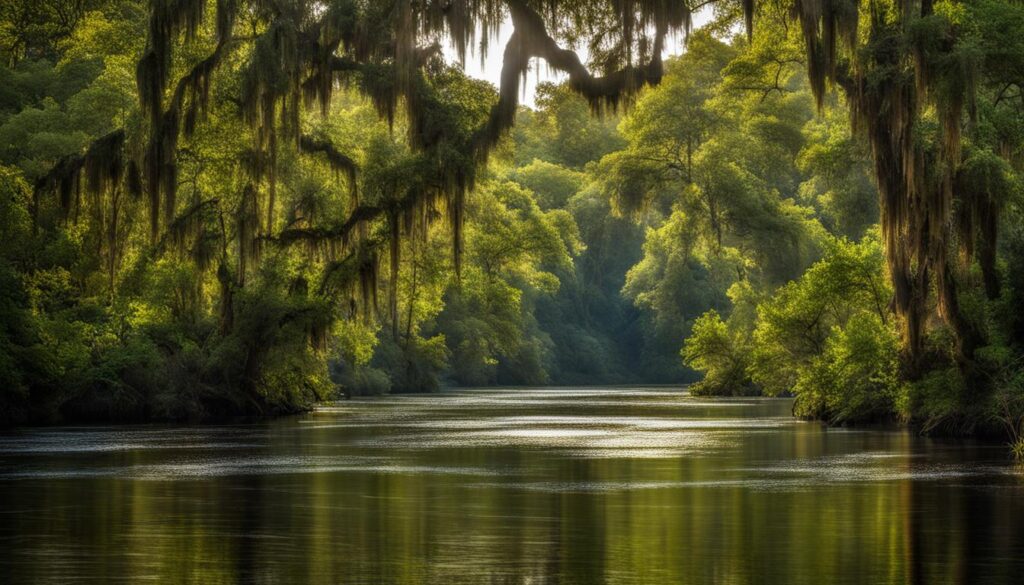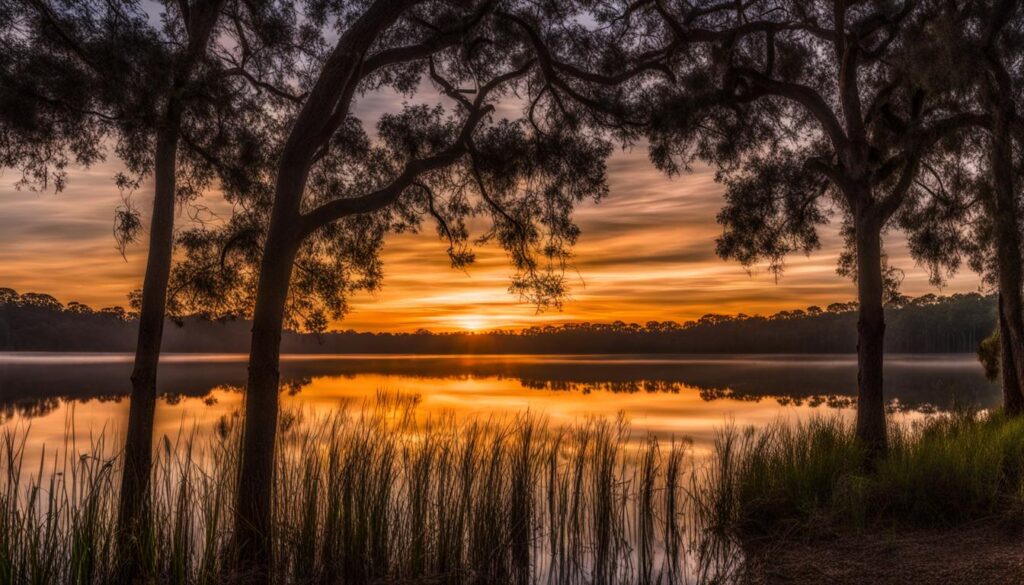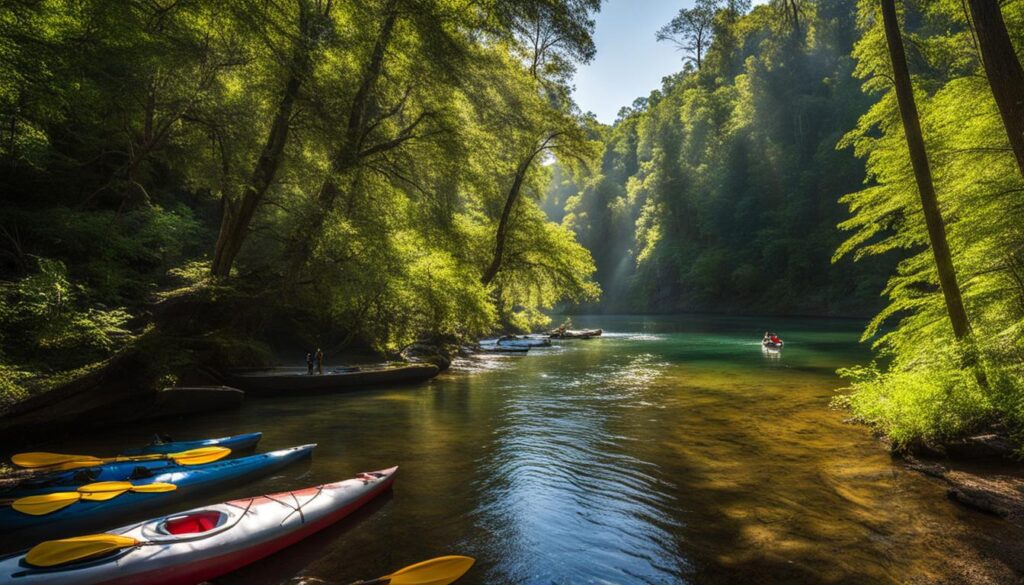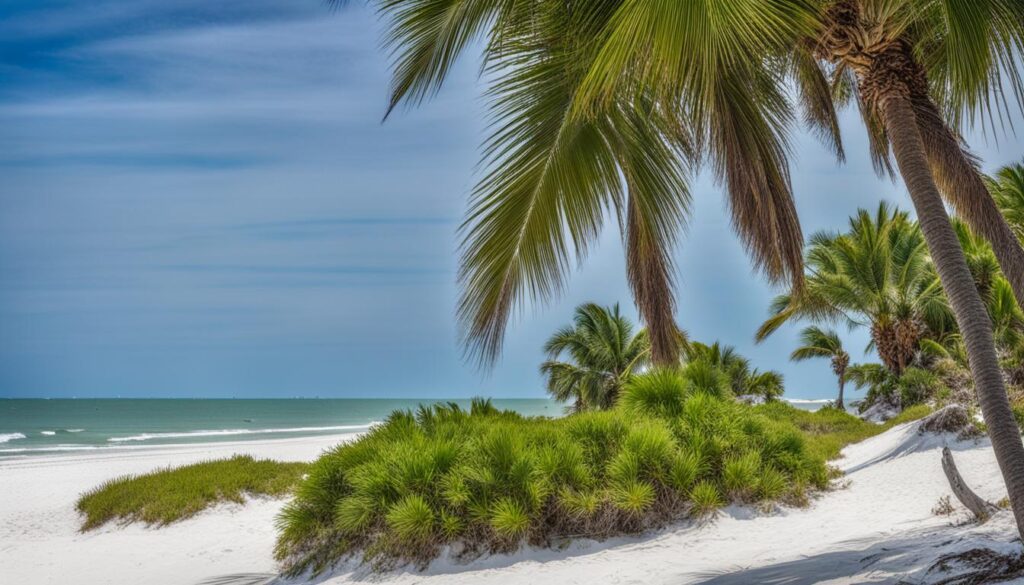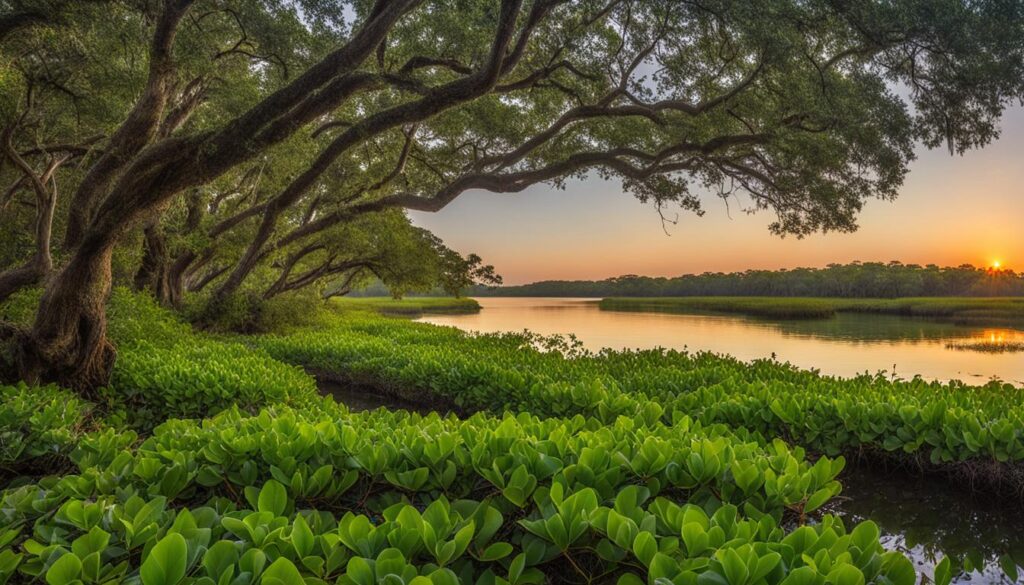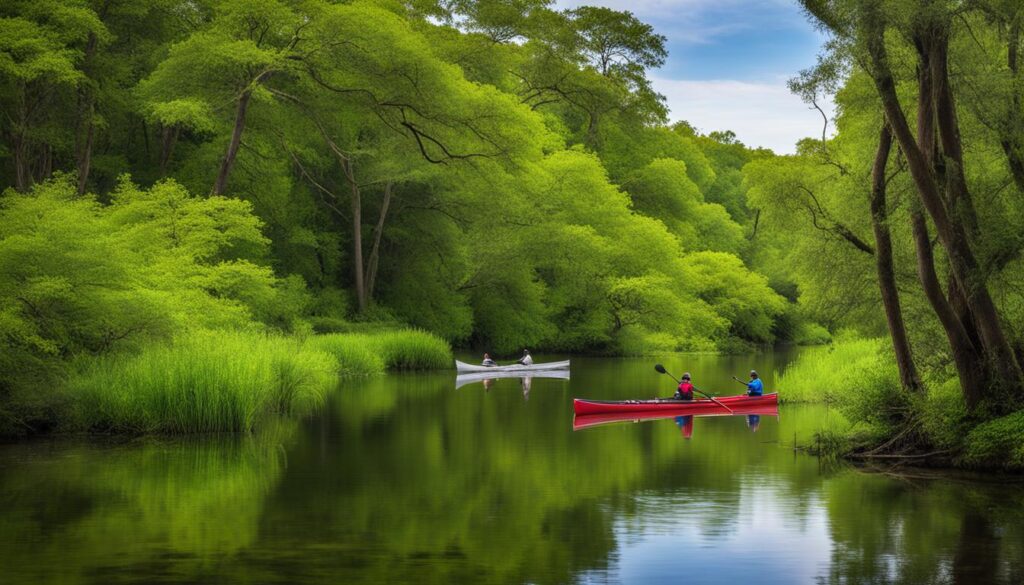Welcome to Lignumvitae Key Botanical State Park, a hidden gem nestled in the beautiful Florida Keys. This pristine park is a haven for nature enthusiasts, offering breathtaking natural beauty and protected areas to explore. Whether you’re a local or a visitor, this park is a must-see on your list of Florida attractions.
Originally purchased by William J. Matheson in 1919, Lignumvitae Key Botanical State Park holds a rich history. Matheson’s former hideaway now serves as the park’s visitor center, providing a glimpse into the past and the unique story of this remarkable place. Accessible only by boat or kayak, the park offers ranger-guided tours and a self-guided tour brochure for those eager to immerse themselves in its wonders.
Key Takeaways:
- Lignumvitae Key Botanical State Park is a hidden gem in the Florida Keys, offering natural beauty and protected areas.
- The park was purchased by William J. Matheson in 1919 and his former hideaway now serves as the visitor center.
- Access to the park is limited to boat or kayak, providing a unique and secluded experience.
- Ranger-guided tours and a self-guided tour brochure are available to help visitors explore and appreciate the park’s wonders.
- Don’t miss the opportunity to discover the rich history and natural treasures of Lignumvitae Key Botanical State Park.
Contents
Essential Information
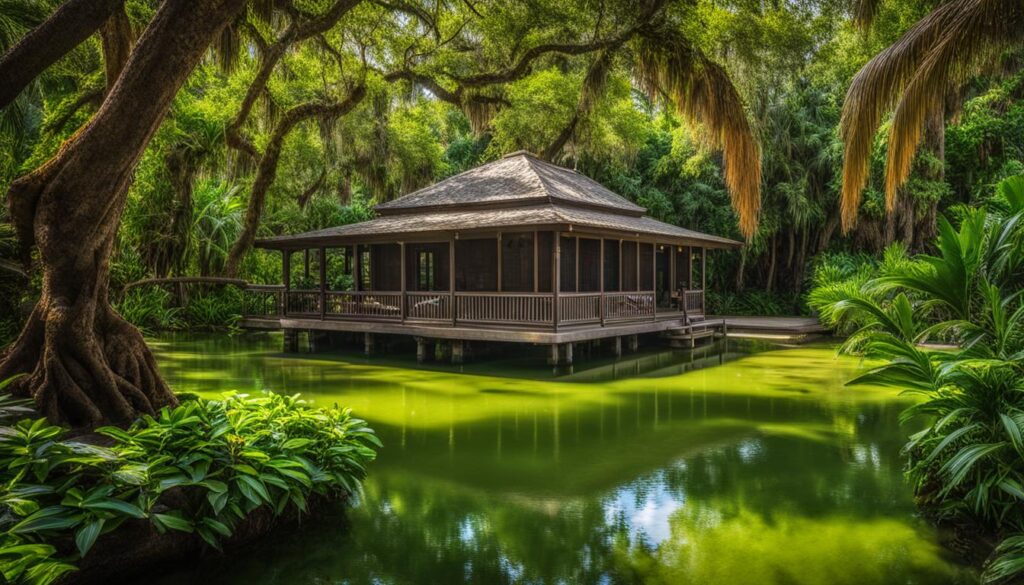
When planning your visit to Lignumvitae Key Botanical State Park, it’s important to have some essential information to make the most of your trip. Here are the highlights, activities, and accommodation options available at the park.
Highlights
The park is home to a two-story house built in the 1930s, a cistern for rainwater collection, and a beautiful hardwood hammock forest. The Matheson House, once the hideaway of William J. Matheson, the park’s founder, now serves as the visitor center. It’s a great place to start your exploration and learn about the rich history of the park.
One of the main attractions at Lignumvitae Key Botanical State Park is the ancient lignum vitae trees, some of which are believed to be over two thousand years old. These majestic trees are a true natural wonder and offer a unique opportunity to witness their grandeur up close.
Activities
There are several activities you can enjoy during your visit to the park. Ranger-led tours are available from December to April, offering a chance to explore the park’s highlights and learn about its flora and fauna from knowledgeable guides.
If you prefer a self-guided experience, you can explore the landscaped yard around the Matheson House using a tour brochure provided at the visitor center. This allows you to take your time and discover the park at your own pace.
Accommodations
While there are no accommodations within the park itself, there are options nearby. You can find hotels, resorts, and vacation rentals in the surrounding areas of the Florida Keys. It’s recommended to book your accommodation in advance, especially during peak tourist seasons, to ensure availability and the best rates.
With this essential information, you can start planning your visit to Lignumvitae Key Botanical State Park and make the most of your time exploring its natural beauty and historical significance. Don’t forget to check the park’s official website for any additional resources and updates before your trip.
Exploring the Area
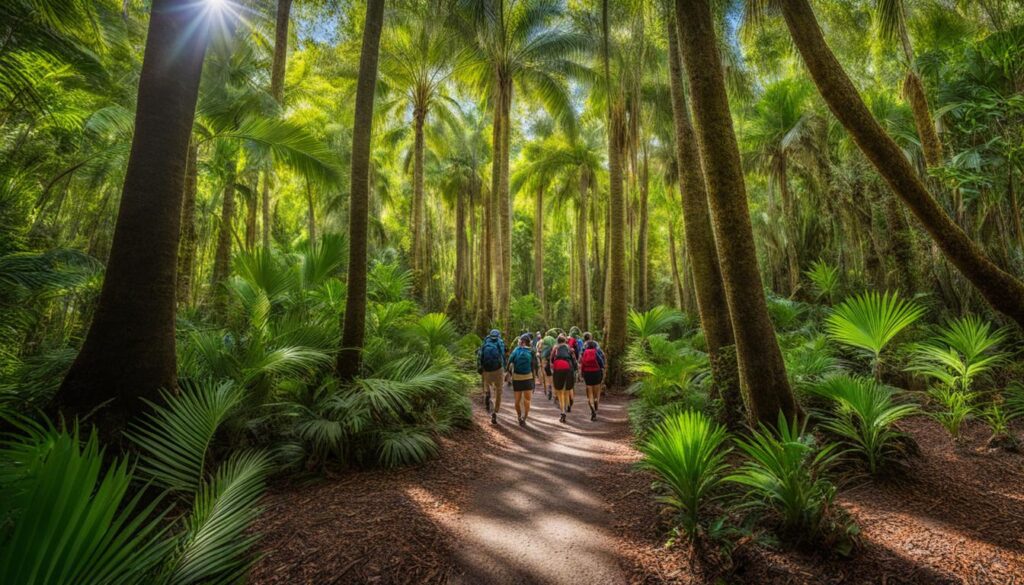
Lignumvitae Key Botanical State Park is a hidden gem nestled in the Florida Keys, offering visitors a unique opportunity to explore its natural wonders. Spanning 280 acres, the park is home to a virgin tropical forest, with the main attraction being the magnificent lignum vitae trees. These ancient trees, some believed to be over two thousand years old, create a breathtaking canopy that provides shade and shelter for a diverse range of plant and animal species.
Exploring the park is a truly immersive experience, with guided hikes led by knowledgeable park rangers available for visitors. These guided hikes take you through the park’s tropical hammock, where you’ll discover rare plant species, such as the Florida purplewing butterfly and the fascinating Liguus tree snails. The hammock is a vibrant ecosystem teeming with life, showcasing the beauty and fragility of Florida’s unique flora and fauna.
In addition to the guided hikes, visitors can also explore the cleared portion of the island surrounding the Matheson House, the former hideaway of William J. Matheson. This scenic area offers stunning views of the surrounding landscape, providing a tranquil setting for picnics or simply enjoying the natural beauty of Lignumvitae Key Botanical State Park.
Services and Facilities
Lignumvitae Key Botanical State Park provides several services and facilities to enhance visitors’ experiences. The park offers restroom facilities and picnic areas, making it convenient for families and groups to enjoy a day outdoors. Additionally, there are designated areas for boat and kayak rentals, allowing visitors to access the park by water.
For those seeking a deeper understanding of the park’s history and significance, the Matheson House serves as the park’s visitor center. Inside, you’ll find exhibits and displays that showcase the rich heritage of the park, including its ties to William J. Matheson and the preservation efforts that have gone into protecting the lignum vitae trees. Knowledgeable staff members are also available to answer any questions and provide further information about the park.
To ensure a safe and enjoyable visit to Lignumvitae Key Botanical State Park, it is recommended to check the park’s official website for any updates or closures. The website also provides additional resources, including trail maps and information on nearby parks and trails, allowing visitors to plan their itinerary and explore the surrounding area to the fullest.
Park History

Lignumvitae Key Botanical State Park holds a significant place in history due to its founding and the preservation of its unique environment. The park’s name itself, “Lignumvitae,” is derived from the lignum vitae tree, which holds immense medicinal value. In 1919, the park’s founder, William J. Matheson, purchased the island with the purpose of conducting experiments and preserving the forest of these valuable trees. The Matheson House, now serving as the visitor center, was constructed using native materials and acted as a caretaker’s home, reflecting the historical significance of the park.
The park’s establishment serves as a testament to the dedication and foresight of Matheson, who recognized the importance of preserving natural resources and the unique ecosystem found on Lignumvitae Key. Today, visitors can explore the park and learn about its history, experiencing firsthand the rich legacy and environmental significance that Matheson worked to protect.
Matheson’s vision for Lignumvitae Key Botanical State Park was not only to preserve the forest of lignum vitae trees but also to showcase the importance of conservation and research. His dedicated efforts have made it possible for visitors to appreciate the park’s historical and ecological value, creating a space that is both educational and visually stunning.
William Johnson, Environmental Historian
The Historical Significance of the Lignumvitae Tree
The lignum vitae tree, with its dense and durable wood, has played a vital role throughout history. Its medicinal properties have made it highly sought after for its ability to treat a variety of ailments, such as arthritis and high blood pressure. The tree’s wood was also used for creating bearings in machinery and even as part of the construction of the Panama Canal. Today, the presence of these ancient lignum vitae trees in the park serves as a reminder of the importance of preserving both natural resources and historical knowledge.
Planning Your Visit
When planning your visit to Lignumvitae Key Botanical State Park, it’s important to note that the park can only be accessed by private boat or sea kayaking. The nearest launch point is Robbie’s Marina located at the north end of Lower Matecumbe Key. Please make the necessary arrangements for boat or kayak rental beforehand to ensure a smooth experience.
The park is open Thursday to Monday, from 8 AM to 4 PM. Keep in mind that there are no accommodations available within the park. However, there are nearby parks and trails that you can explore. Notable options include the Green Turtle Hammock Nature Preserve and Plantation Hammocks Preserve. These natural areas offer additional opportunities to immerse yourself in the beauty of the Florida Keys.
Nearby Parks and Trails
In the Green Turtle Hammock Nature Preserve, you can discover mangrove forests, tidal creeks, and a variety of bird species. The preserve offers scenic trails for hiking and birdwatching. Plantation Hammocks Preserve, on the other hand, showcases a diverse ecosystem of tropical hardwood hammocks, providing a tranquil setting for nature enthusiasts.
For more information and detailed trail maps, I recommend visiting the official website of Lignumvitae Key Botanical State Park. They provide additional resources to help you plan your visit and ensure you have a memorable experience exploring the natural wonders of this protected area.
FAQ
Can I reach Lignumvitae Key Botanical State Park by car?
No, the park can only be reached by private boat or sea kayaking. The nearest launch is Robbie’s Marina at the north end of Lower Matecumbe Key.
What are the operating hours of Lignumvitae Key Botanical State Park?
The park is open from 8 AM to 4 PM, Thursday to Monday.
How can I explore the park?
Visitors can take ranger-led tours from December to April or explore the cleared portion of the island around the Matheson House using a self-guided tour brochure.
Are there any nearby parks and trails to explore?
Yes, you can also visit Green Turtle Hammock Nature Preserve and Plantation Hammocks Preserve in the area.
Where can I find additional resources and trail maps?
You can find additional resources and trail maps on the park’s official website.
Source Links
- https://www.floridastateparks.org/learn/lignumvitae-key-island-tour
- https://www.floridastateparks.org/LignumvitaeKey
- https://floridahikes.com/lignumvitae-key-botanical-state-park
Check out these other Florida State Parks:
Check out our other Florida guides to find parks in Central Florida near locations like Anna Maria Island, Bradenton, Clearwater, Cocoa Beach, Davenport, Daytona Beach, Disney World, Dunedin, Kissimmee, Lake Mary, Lakeland, Leesburg, Ocala, Orlando, Sarasota, St Petersburg, Tampa, Universal Studios Orlando, and Venice. Or North Florida parks near Cedar Key, Gainesville, Jacksonville, Lake City, Palatka, and St Augustine.
We have guides for South Florida locations near Cape Coral, Fort Lauderdale, Fort Myers, Key West, Miami, Naples, Pompano Beach, Punta Gorda, Sanibel Island, Stuart, Vero Beach, and West Palm Beach. If you're looking for parks in the Florida panhandle, there are parks near Destin, Fort Walton Beach, Marianna, Mexico Beach, Panama City, Pensacola, and Tallahassee. There are also plenty of Florida parks near Crystal River, Deland, Homosassa, Silver Springs, and Zephyrhills.
